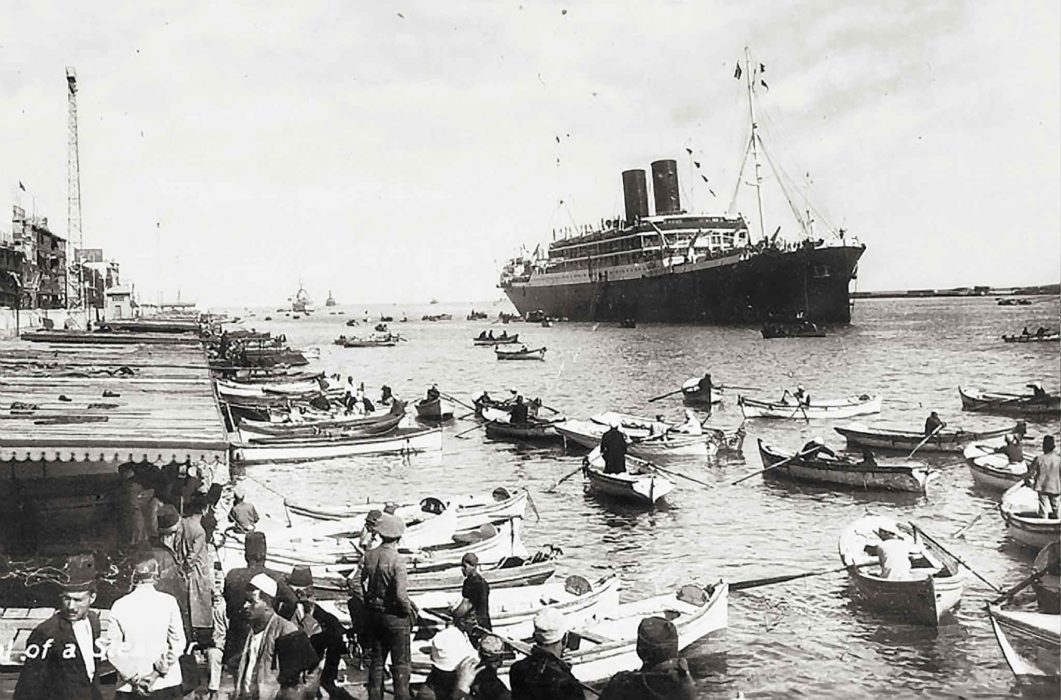IN 1898 IT WASN’T easy to see ‘Abdu’l-Bahá. He was still a political prisoner after thirty years, and Ottoman government spies reported on his activities. It was a dangerous prospect for him to be seen welcoming one of America’s wealthiest and most famous women into the prison city of ‘Akká in the bright light of day. Therefore, Phoebe Hearst stole into ‘Akká under cover of night.
Not long after she had first heard of ‘Abdu’l-Bahá and his father, Bahá’u’lláh, Mrs. Hearst had planned a trip to Egypt and Palestine, and had invited some younger members of her family and a few friends. The pilgrims arrived in small groups so as to avoid raising the suspicions of the authorities; Mrs. Hearst, her maid, and her British friend, Mrs. Thornburgh-Cropper, reached Palestine on or around Tuesday, December 20, 1898. “Mrs. Hearst and I arrived in Cairo, Egypt, after a terrible storm at sea,” her friend later wrote, “and remained there for a few days until all had been explained to us regarding our actual journey into the prison city.”
After a storm-tossed trip to Haifa in “a small, miserable boat,” the ladies checked into a hotel to wait for the sun to retire. Once darkness descended they mounted a carriage for the five-mile trip around the bay to ‘Akká along the hard beach sand. The carriage entered the prison city’s wooden gates, and turned left toward the house of ‘Abdu’lláh Páshá, a residence originally built about 1817 by the governor of the city, but which was now a run-down complex of apartments whose stucco suffered from an advanced stage of decay. ‘Abdu’l-Bahá had rented rooms for his family there in 1896.

Mrs. Hearst’s party rode the carriage up to the building’s studded metal gate, walked in the darkness through a courtyard decorated with a roughly-hewn geometrical garden, and started up a long flight of uneven stone steps, which clung to the outside wall of a four-story building in the southwestern corner of the complex. “Someone went before us with a small piece of candle,” Mrs. Thornburgh-Cropper wrote, “which cast strange shadows on the walls of this silent place.”
At the top of the stairs, a small courtyard on the top level of the building, which transmitted light and air throughout the upper rooms during the day, opened to the night sky. They turned left, climbed one more step, and entered a plain-looking reception room that faced due west across the stormy Mediterranean waters. Low divans tucked up underneath the western windows, the ceiling was high, and cedar panels wrapped the space, absorbing the salty spray from the ocean waves which smashed up against ‘Akká’s old sandstone sea wall just beyond the windows.
“Suddenly the light caught a form that at first seemed a vision of mist and light,” Mrs. Thornburgh-Cropper wrote. “It was the Master which the candle-light had revealed to us. His white robe, and silver, flowing hair, and shining blue eyes gave the impression of a spirit, rather than of a human being. We tried to tell Him how deeply grateful we were at His receiving us.”
“No,” ‘Abdu’l-Bahá answered in carefully measured English, “you are kind to come.”

Due to the danger that such a prominent American visitor could bring down on ‘Abdu’l-Bahá, Mrs. Hearst spent just three days in ‘Akká. On February 20 her butler, Robert Turner, arrived from Egypt, becoming the first African American to meet ‘Abdu’l-Bahá. “God gave you a black skin,” ‘Abdu’l-Bahá told him, “but a heart white as snow.”
Fourteen years later, on October 14, 1912, a freed ‘Abdu’l-Bahá arrived with Mrs. Hearst at her hacienda in Pleasanton, California, in the bright morning sunshine. The next evening, over dinner, she told the story of her pilgrimage to a privileged group of guests. “Those three days were the most memorable days of my life,” she later wrote.
Today’s feature is based heavily on the story and descriptions of Mrs. Hearst’s pilgrimage as told by Kathryn Jewett Hogenson on pages 96 to 101 of her book, Lighting the Western Sky, published in Oxford by George Ronald in 2010. If you would like to purchase the book, you can buy it here on Amazon.com.






